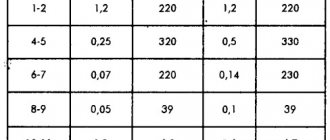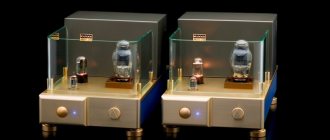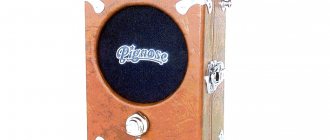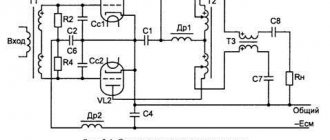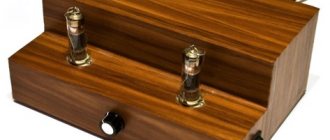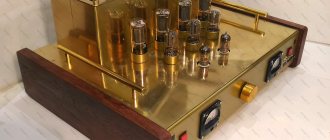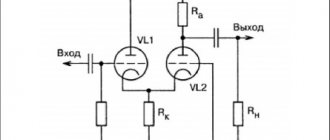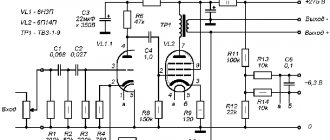Tube amplifier SQ-N100 At first glance, the very concept of “tube sound” can be classified as one of the transonic phantoms that have accumulated quite a lot in the audio field. Indeed, amplifiers can be good or not so good, but how they are implemented is the fifth question. Nevertheless, if we leave aside the most exotic designs, common features can be found in the behavior of vacuum tube amplifiers. And therefore, indeed, we can talk about tube sound, not forgetting that this is a simplification. In particular, single ended and push pull amplifiers differ in their sound signature. In terms of the linearity of their characteristics, lamps are not inferior (at least) to transistors, but a powerful amplifier stage can be connected to acoustics only through an output transformer. And a high-power broadband transformer is a conglomerate of problems that can never be completely solved; one can only get closer to this solution.
A little history
As you know, in 1905, while experimenting with incandescent lamps, Addison accidentally invented the diode.
And a year later, by adding a third electrode (control grid) to the lamp, a triode or electronic amplifying lamp was invented. This marked the beginning of the lamp era.
Lamps gained enormous popularity 30 years after their invention. Their popularity lasted from 1935 until 1951.
In parallel with the lamp, the development of a semiconductor triode (transistor) was underway. And when mass production of transistors began in 1951, the lamp gradually began to lose ground.
Why did people start switching to transistors in audio?
There are several main reasons for this. The first concerns the fact that the radio tube began to lose to the transistor in terms of operating speed, size and energy consumption. Thanks to transistors, it has become possible to create high-quality compact devices.
Also, transistor amplifiers were significantly cheaper with the same or even better sound characteristics than tubes.
One of the main elements that introduce noticeable distortion into a tube amplifier is the output transformers, which also add a good amount to the cost of the amplifier. In a tube stereo amplifier you can find one for each channel.
There are also transformerless tube amplifiers, but they only work on special acoustics. In addition to this, they are very rare and we will not consider them.
An indisputable fact in principle: tube amplifiers and in general everything tube plays better than transistor ones...
The epithets “warm, cozy, tube…” refer only to tube designs, and the best praise for a transistor amplifier from advanced music lovers is “it sounds like a tube device...”
The question arises completely honest and justified - why should transistor amplifiers actually sound worse than tube amplifiers? After all, progress does not stand still, people have iPhones of the sixth model in their hands, smart watches, all of this is assembled on semiconductor chips and works great, etc. Can't progress do the same with sound??? For what reason is it that the entire electronics industry cannot achieve the same natural sound from transistors as from almost century-old tubes? And is this really so, as numerous sound experts claim, saying that tubes play better... Maybe they are wrong and there are transistor amplifiers that are better than tube ones???
A person who loves music has a lot of questions, especially someone who is at least a little technically savvy.
I have been working on amplifiers for almost 30 years, of course, not so much that I solder every day and listen to the difference in their sound, like many advanced electronics engineers and “tube makers”... Due to my occupation and hobby I have to constantly communicate with such people, plus many years of various experiments with sound and Assembling kits for playing music for completely different “ears” gives quite interesting considerations and conclusions.
There are several reasons why a tube amplifier plays better than a transistor one:
Number of stages
A tube amplifier has much fewer stages (series-connected sections) than a transistor amplifier. In a tube amplifier, regardless of its architecture (there are single-ended, push-pull, bridge configurations), there are usually from 2 to 4 stages. This means that a linear signal from a CD player or other sound source with a standard voltage of 0.25 - 0.75 volts is amplified in current and voltage to achieve an output power of 10 - 100 Watts with only 2 - 4 amplifier sections. This almost never happens in transistor amplifiers; the number of amplification stages ranges from 10 to 20 units...
To the question why a transistor amplifier has 20 stages, while a tube amplifier with the same output power has only three, I will answer in the subtitle “Quantity and quality of elements in the design.” But there is an indisputable fact in audio engineering: the number of stages of a transistor and tube amplifier with approximately the same parameters differs by 4–8 times.
(The sound is influenced by almost every element that is in the path of the sound signal. In transistor amplifiers, there are hundreds of elements in the signal chain and these “hundreds” contribute to the sound, while tube amplifiers have an order of magnitude fewer of these elements).
Temperature
Lamps are initially high-temperature elements; their cathode, heated to thousands of degrees, emits electrons that fly to the anode through the control grid. The lamps are stably heated and are not subject to external temperature fluctuations, that is, they seem to be in the same high-temperature regime all the time. Plus, electrons in lamps are emitted by a metal cathode and fly to either a metal or graphite (carbon) anode through a metal (sometimes gold-plated) mesh.
Transistors, unlike lamps, cannot operate at high temperatures. The size of the transistor crystal is very small compared to the dimensions of the cathode and anode of the lamp, and approximately the same power should be released on this crystal (with comparable output power of the lamp and transistor apparatus). Since the sound signal is of a pulsed nature, in a short time, when the pulse increases, the miniature semiconductor crystal of the transistor is instantly heated to a high temperature. It simply physically cannot transfer this temperature to the radiator quickly due to the effect of “thermal inertia”. Cooling radiators for powerful transistor amplifiers are large in size and weight, and over a long period of time they provide cooling of transistors to operating temperatures (maximum 50 - 60 degrees), but cannot cope with instantaneous heating of the crystal. Due to local and rapid heating of the crystal, the transistor parameters “float”. To bring the parameters of the “floating” transistor back to normal, feedback is turned on, which, like radiators, has a certain inertia. The feedback does not keep up with the fast pulse signal and is simply turned off at the first moment, the cascade enters the limit and in these milliseconds produces a signal that is maximally distorted.
Current/Voltage Relationship
Transistors, unlike lamps, are initially low-voltage elements and for the most part they cannot withstand high voltages. This happens due to the fact that the distance between the electrodes of the transistor is hundreds of times less than the distance between the cathode and anode of the lamp. Because of this, the permissible operating voltage of transistors is much less than that of a lamp and, as a result, transistor circuits are built using low-voltage power supplies. For example, a 20-watt tube amplifier has a power source and an operating (anode) voltage of 300 Volts, and a transistor amplifier with the same output power is 30 Volts. According to the law of conservation of energy, the current flowing in a tube amplifier is exactly 10 times less than in a transistor amplifier.
What does this give?
All elements that participate in amplifying the signal of a tube amplifier are much less loaded with current than the elements of a transistor amplifier, which means that the area of the conductors of a tube amplifier can be much smaller than that of a transistor amplifier, the capacitance of the capacitors is also an order of magnitude smaller, etc.
By the way, it is precisely because of the high currents in the transistor amplifier and the low operating voltage of the supply to its cascades that electrolytic capacitors are widely used. And electrolytic capacitors “electrolytes”, no matter how high quality they are, are by nature nonlinear elements. In tube amplifiers, electrolytic capacitors are practically not used along the signal path, but in transistor amplifiers they are installed everywhere. The capacity of electrolytic capacitors in a transistor amplifier is hundreds of times greater than in a tube amplifier with similar parameters. There is a direct pattern: the higher the capacity of the electrolytic capacitor, the more noticeable contribution it makes to sound (degradation).
Audiophiles have noticed a rather interesting property in tube devices - amplifiers sound clearly better if they operate with low currents and high voltages. There are special lamps that are designed to operate at a relatively low anode voltage and high current, for example: 6s-33s or 6-18s. So, although tubes of this type are used in certain models of tube amplifiers, they are not widely used. They, just like transistor ones, require a large current from the power source and large values of electrolytic capacitors, as a result they turn out to be a kind of hybrid between transistor and lamp units. Such lamps are used mainly for constructing transformerless tube amplifiers. But companies that rely on the lack of an output transformer as their main goal get a bunch of other problems.
Feedback
Feedback (negative) is intended to correct the nonlinearity of amplifiers and obtain objectively higher performance from them. That is, an amplifier with feedback has a wider frequency band and less nonlinear distortion than without it. But feedback, improving the objective parameters of the amplifier, has its pitfalls. It, as a rule, covers the entire amplifier, and corrects its nonlinearity as a whole, and distortions in each stage arise purely differently and each stage is nonlinear in its own way... Plus, negative feedback has a response time, which is longer, the greater the number of stages in the amplifier. At fast peaks of the signal, the feedback does not have time to operate, which leads to the microsecond input of the amplifier into limiting the signal with 100% “clipping” distortion, which in normal mode does not manifest itself in any way, so-called “dynamic distortion” occurs.
Due to the fact that transistor amplifiers are initially more nonlinear than tube amplifiers and have a larger number of stages in comparison with them, the feedback depth in them is much higher than in tube amplifiers. For a transistor amplifier, a feedback depth of 60 dB is considered normal, while in a tube amplifier it usually does not exceed 15 - 20 dB. The greater the depth of feedback, the higher the interference in the operation of the amplifier and the greater the level of correction of its primary nonlinearity. Audiophiles quite often turn off feedback in their tube devices or make it minimal. Yes, at the same time, nonlinear distortions increase, the frequency band narrows, and high quality requirements arise for almost every element included in a tube amplifier. But the sound without feedback becomes fast, atmospheric and airy. In a transistor device, it is almost impossible to turn off feedback, since the amplifier will not work without it.
Quantity and quality of elements in the design
A tube amplifier is usually assembled from dozens of elements: tubes, resistors, capacitors, etc. transistor from hundreds and thousands. Everything is simple here - the fewer elements are in the path of the signal, the less influence they have on this signal. Tube companies assemble amplifiers with the utmost care in the selection of each element included in it. And this selection is carried out not only and not so much by face value, but by the influence of these elements on the sound. For example, they try to install carbon resistors in tube amplifiers, since they frankly perform better than metal-ceramic resistors, and metal-oxide resistors, although they have larger dimensions, are subject to temperature instability and are less reliable.
In lamp designs, paper and metal-paper capacitors are widely used, which are a priori better than electrolytic capacitors, which are installed in the hundreds in transistor devices. It is simply impossible to install paper capacitors in transistor amplifiers, since they require capacitor ratings of 10 - 1000 microfarads. An electrolytic capacitor with a capacity of 100 microfarads in a transistor amplifier is the size of a cigarette filter, and a paper capacitor of the same value looks like a half-liter can of beer. And a transistor amplifier needs 50–100 such capacitors. Now imagine the dimensions and cost of a transistor amplifier with such capacitors. In a tube amplifier, due to the high supply voltage and low current, it is enough to install 1 - 2 such capacitors. Extremely small currents (compared to transistors) flow in the stages of a tube amplifier and require capacitors with tens of times less capacitance. Paper or film capacitors, which are universally installed in tube amplifiers, like lamps, are high-voltage elements that have a low capacitance compared to electrolytic ones of the same size. It’s as if they were made for each other.
About the difference between tubes and transistors as amplification elements. Here the advantages of lamps are not so obvious; rather, transistors as amplifying elements work no worse, and even better, than lamps. They are more reliable, they have higher efficiency, and they do not reach temperatures dangerous for people. But this has a very mediocre relationship to sound. On the path of electrons in the lamp, only linear materials are encountered, these are the metal of the cathode, grid and anode. The anode is sometimes made of graphite, which - remembering that carbon (graphite) resistors perform better than ceramic and metal oxide ones, leads to the conclusion that a graphite anode is no worse than a metal one. Transistors initially use a material called a semiconductor: rare earth germanium, silicon or gallium arsenide. A semiconductor is not a metal, and this composite material stands in the way of electrons leaving the emitter (cathode) and traveling to the collector (anode). A semiconductor introduces specific distortions inherent only to it into the signal, which have received the slang nickname “transistor”.
Many radio amateurs did an experiment, built cascades of almost identical architecture, on a transistor and a lamp, and compared their sound. I have never heard anyone say that a transistor cascade sounded better.
Bottom line
A huge number of companies produce transistor and tube amplifiers. Transistor ones have an undeniable advantage - they are extremely reliable, repeatable and less material-intensive per unit of power delivered to the speakers, which means they are more profitable in production. Mainly because of these considerations, we see the dominance of transistor amplifiers on sale and aggressive advertising to promote them. It is more difficult with lamp devices - they have a rather specific appearance, require careful handling and periodic (every 3 - 5 years) replacement of lamps. Plus, there is a general human prejudice against everything that was invented and produced in the middle of the last century. But here are the facts: The best microphones in recording studios have used tube amplifiers for over 50 years, and 99% of the world's advanced audiophiles have tube paths in their systems. Especially if their system has a vinyl player.
Author: Vitaly Aovoks
You may be interested in:
|
Comments on articles on the site are temporarily disabled due to a huge amount of spam.
Tubes in audio equipment
Progress has affected all electronic devices, but we will focus on audio equipment.
Most often, tube amplifiers (in the transistor era) were used in recording studios to amplify the signal from condenser microphones. Due to the high input impedance and less distortion when the sound volume is exceeded, it was convenient to use them.
It is also now very popular to use tube amplifiers for electric guitars, due to the distortion introduced into the sound, which is called “Distortion”.
In home amplifiers, before the advent of transistor options, users simply had no choice. And when transistors appeared, they began to highlight a special sound from the advantages of tube amplifiers, which later became known as “warm” tube sound.
Gradually, tubes were supplanted by transistors from the mass amplifier market and remained only in the expensive (Hi-End) or amateur segment.
6V6
6V6 tubes began to be produced shortly after the first release of 6L6 in the late 30s. This little brother is less powerful than the 6L6 and does not require a powerful and expensive transformer in order to work properly. Lamp output power 7-12 W. This is a great choice for home amps like the Fender Champ. Despite having less power than the 6L6, the 6V6 is very similar. The bottom is large and voluminous, the tops are sparkling, but the lows of this particular lamp are more elastic and easier to control, and the highs are softer, they do not have the sharpness and sharpness that the 6L6 has. I also hear clearer mids. Overall, the 6V6 is a very balanced tube. The highs are bright and the mids aren't as suppressed. The attack is softer, there is a good balance of highs, mids and lows, and a calmer tone. Despite its differences with the 6L6, the 6V6 is also considered an epithet of American sound.
Has progress stopped?
The most interesting thing is that there is no dispute about the picture quality of televisions, which, as you know, have also evolved from tube ones. If you compare televisions of the lamp era with modern ones, then even an ardent supporter of lamps will not argue which is better.
The same can be said about computers, phones and other devices. They have become much better and more accessible. So, it turns out that progress has stopped only at sound devices? Don't you think this is strange?
What will the measurements of a single-ended tube amplifier show?
Most often, tube sound lovers use single-ended tube amplifiers for listening. One of them was kindly provided to us by radio amateur Dmitry.
Thanks to measurements of the sound of single-ended tube amplifiers, we found out something. Unlike transistor ones, which have more odd harmonics, tube ones are dominated by even ones and, more often, the second harmonic, which gives ordinary sound a special sound.
During listening experiments, it was revealed that our hearing is not hurt or tired by increased even harmonics, unlike odd harmonics, which predominate in transistor amplifiers.
The figure shows the increased second harmonic of a single-ended tube amplifier, which also gives it a distinctive sound.
RMAA test results
Measurement at a power of 1.5 Watt see Measurement at a power 4 Watt watch
The secret of tube sound
If we discard the visual perception of a tube amplifier and imagination, then, most often, the secret of the tube sound is this second harmonic. And also the predominance of even harmonics. Also, very often the frequency response of such amplifiers begins to fall off at high frequencies due to the characteristics of the transformer and they do not sound so sharp.
It seems simple, doesn't it? But not everyone agrees with such simple explanations and comes up with magic and parameters that are inaccessible to modern measurements, using definitions that are not characteristic of sound.
Hand assembly is awesome
No. A person is more likely to make a mistake than a properly tuned machine. However, some amplifiers are still assembled by hand, but not to imbue the unit with the “aura of a craftsman.” As a rule, this applies to old, classic models that do not have printed circuit boards. A robot that can properly cut, bend, and solder the leads of the parts to the contacts in the amplifier case (this is called “surface mounting”) will cost a lot of money and will be difficult to set up.
The insides of a classic Fender Tweed amp. This can only be assembled by hand. Photo from here
Therefore, such circuits are assembled manually, not forgetting to then indicate this fact on the label and pass it off as a feature that costs extra money. Manual assembly can also be profitable if the batch of devices is very small. But for such a rare product you will have to pay a lot anyway.
Liked? Share with your friends!
Playback source
Very often in disputes about sound quality, they forget about the sound source itself. An amplifier actually only amplifies the signal. And if the signal quality is bad, for example with noise, it will amplify it also with noise and the sound will be bad.
Until recently, there were disputes that digital sound was completely unsuitable for playback and therefore audiophiles listened to sound from records or reel-to-reel tape recorders. They lost this war. After all, now the majority have switched to digital sound, because it is better and more convenient. Now they are arguing about which digital signal converters are better. Perhaps they just like to argue?
6L6
The 6L6 tube is widely used in American amplifiers and has become synonymous with the Californian sound. These tubes are used by Fender, Mesa Boogie and many others. Of all four types of tubes discussed in this article, the 6L6 has the most spacious sound, it is more difficult to drive, and you need to make the amplifier louder. The power of one 6L6 lamp is up to 30 W, depending on the amplifier circuit. I've come across small 15W 6L6 amps, as well as 60W guys like the Hot Rod DeVille, so there are plenty to choose from.
EHX 6L6
In my opinion, the 6L6 has a very powerful, slightly boomy low end - and that's great. When we turn on such an amplifier louder, the tubes begin to overload and compress the sound, the low end becomes denser (depending on the circuit of the particular amplifier). The highs are best described as "sparkling". The 6L6 is generally a fairly bright tube that can sometimes be worth dimming a little. Bright highs and expressive lows create the impression that the middle has failed. Prominent representatives of this sound are the Fender Twin Reverb, Vibrolux and Blues Deluxe amplifiers. It's a classic glassy Fender sound. Despite the large margin of safety, the 6L6 sounds very cool when you overdrive it. Luscious compression and vintage character. The mids and lows work well together, and the raised top adds punch and brightness to the sound.
Acoustics for tube amplifier
Acoustics is often forgotten when choosing an amplifier, although in fact it is the most important thing. An incorrectly selected speaker-amplifier pair can ruin the sound, no matter how much money you bought it for.
For example, if an amplifier is designed for 8 ohm acoustics, and you connect 4 ohms, then the amplifier will operate with a load unusual for it. Or if you connect a single-ended 5-watt tube amplifier to weakly sensitive acoustics, then you will not get the sound that it should be, and you will conclude that the amplifier is bad.
Tube tetrodes and pentodes do not work well with multiband acoustics due to their high output impedance, so they need to be listened to on wideband acoustics. A tube triode amplifier is not so demanding on this and sounds normal on almost any acoustic system, like most transistor ones.
Also, do not forget that if your room is empty, then when listening, the sound will be reflected from the walls and will sound bad, but this is a different topic.
Content
- 1 Source
- 2 Theory
- 3 The essence of audio sracha
- 4 Symptoms
- 5 Warm tube monitors 5.1 Among gamers
- 5.2 Cold tube CCFL vs soulless LED crap
- 5.3 Actually
- 21.1 Media
Is it worth switching to lamps?
Only you can answer this question yourself. The most correct way is to take a tube amplifier to your home for an audition and answer it yourself. You will have the opportunity to compare in a quiet environment, for example with your amplifier, and then draw conclusions.
Opposite reviews about tube sound and amplifiers are often voiced, from “divine” sound to the definition of “ordinary” or “bad” sound. And only you yourself can determine what it is for you.
We do not recommend relying on reviews about tube or other amplifiers; very often they are written either by interested people or by those who have not heard these amplifiers at all.
The debate about whether to use tube amplifiers or switch to them from transistor ones is actually similar to the debate: “Should I drive regular cars or switch to vintage cars?” After all, there are very beautiful retro cars, with expensive interiors and good power. If you have money, you can make a copy of such a car and enjoy driving it. There is an excellent expression on this topic - there is no arguing about tastes.
Are these cars suitable for everyone? Of course not, but you are not “everything.” The main thing is that you personally like it and enjoy it.
A combination of retro and modern technologies
I chose LynePAudio A962 as the most affordable and versatile.
So, on board we have:
- output amplifier stage with 2 6zh9 lamps in Chinese design,
- built-in digital DAC with audio stream decoding 16-32 bit, 44.1/48 KHz,
- ASIO support,
- 2 high-impedance headphone outputs with impedance from 16 to 600 Ohms,
- stereo line output to RCA for use as a preamp,
- digital input (USB),
- analog input 3.5 and RCA.
Does it inspire? Of course, because the final power of the amplifier is 1.1 W for a load of 32 Ohms. For a desktop toy, this figure is enough to even drive monitors, not to mention any portable headphones.
The board is neatly packaged in a beautiful case and can decorate any interior. Especially the desktop. Very cool! And it really saves time - even if you have to modify it later.
The appearance of the LynePAudio A962 is really worth it to buy a finished product rather than bother with a homemade product. Convenience and ease of use are even more important. Turned it on - use it.
To work with digital audio sources, no drivers or additional software are required (unless you use a smartphone). The built-in DAC is digital and digests most formats coming from a computer or smartphone: it eats MP3, FLAC, and WAV. However, there is a limitation to 32 bits and 48 KHz. DSD does not digest at all.
If you have a high-quality DAC, you can do without the built-in one. For this, LynePAudio A962 has a separate analog input (3.5 mm mini-jack). Not the best solution, but sometimes it comes in handy. It works surprisingly stable, but requires a thick wire. Preferably with good shielding.
Where is the best place to buy tube amplifiers?
If, after listening and comparing a tube amplifier with other amplifiers, you decide to go with a tube, then the answer to the question “Where to buy?” depends on your financial capabilities. If you don’t have a lot of money, we recommend paying attention to radio amateurs who work on tube amplifiers.
Within $500-1000 you can get a good homemade tube amplifier. As a rule, you can take such an amplifier home for listening and buy it if you like the sound.
If you are not constrained by finances, then there will be many well-known brands that, in addition to sound, will sell you a prestigious and beautiful device.
conclusions
A tube amplifier is inferior to other amplifiers in terms of power consumption, has a lot of weight and requires a long warm-up of the tubes to enter normal mode before listening.
Also, a tube amplifier generates a lot of heat during operation and can easily heat up a small room, so in hot weather you will need to buy an air conditioner.
If we talk about single-ended amplifiers, they are easier to set up and their sound has a specific “tube sound”, thanks to the increased second harmonic. That's why they are in great demand among users.
If we take push-pull tube amplifiers (or even more complex ones), then their sound is similar to transistor amplifiers, but several times more expensive than a similar transistor amplifier.
